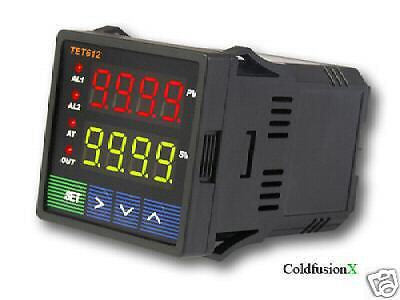Here's some pics of a "hot box" I made for accelerating the cure time of vac-bagged glider wings. Its 4 feet long and 2 feet across, 18" deep
Made of 3/4" blue foam, with aluminum foil inside (foil sprayed with 3M77 adhesive).
Uses a 4" cooling fan that runs constantly, no speed control.
The heat source is simply two light bulbs.
I found that with 100 watt incandescent bulbs, it got as hot as 147 degrees. That was too hot for the vac-bagged wings, risking the foam core getting melted. So, I changed to two 60 watt bulbs which brought the heat down to 120-125 degrees.
Therefore, mine is a "dumb" hot box. It is on constantly and simply tops out at about 125 degrees because that is as hot as the two 60 watt bulbs make it get. Which is perfectly fine for my needs.
So, I would guesstimate that if you used four 100 watt bulbs, that might be enough to reach the 190 degree max temp you want. If not, then 5 or 6 bulbs.
Way less dangerous than using an actual heating element.
I leave it to you to work out how to get the Arduino to safely interface with a relay or whatever to turn the lights on and off. The simple way would be to turn all on or all off. But a more consistent way would be to control each bulb so that once it has reached the desired temperature, it would turn one bulb off when it got a bit too warm then when it got a bit cool turn that one bulb back on, while the rest stayed on (well, if you wanted 170 degrees, the rest would probably need to be on. For say 120 degrees you'd need several to be off. The idea here being that you arrange the programming so one bulb is the one that actively goes on and off to hold the desired temperature, not all of them). Set it for off when 1 degree above the set temperature and to turn back on when 1 degree below the set temperature, or whatever works best once it's running and you tweak it. It would involve a bit of programming tinkering to work out how to make the other bulbs be on, or off, thru the whole temperature range you want it to operate.
As for the temperature probe, just get a thermistor to create a proportional voltage change, a thermocouple is overkill for this.
Here is a link on how to use a thermistor with Arduino:
https://learn.adafruit.com/thermistor/overview
if I was doing it, I'd have the thermistor and the temperature lead from an indoor/outdoor thermometer at the same place, and take note of what number the thermistor was reading when the digital thermometer reads 90 degrees, 100 degrees, 110 degrees, and so on up to 190, and extrapolate the numbers in between. Or if I did not have the patience for that (could set up a video camera to record both), I'd just use the thermistor data sheet to help to fill in most of the data points, and just take the low end and high end of the thermistor and thermometer readings to set the calibrated endpoints. I assume for your needs it would not matter if say when you set it for 140 degrees, if it was 138 or 142.
Now, having said all of that, if you really did want calibrated accuracy within a degree, then you could get a digital temperature sensor. The output for those can be read in a manner that is already calibrated in degrees Celsuis (For Farenheit, you'd program the Arduino to convert).
Here's one link on using those:
https://learn.adafruit.com/tmp36-temperature-sensor/using-a-temp-sensor
- George Gassaway











